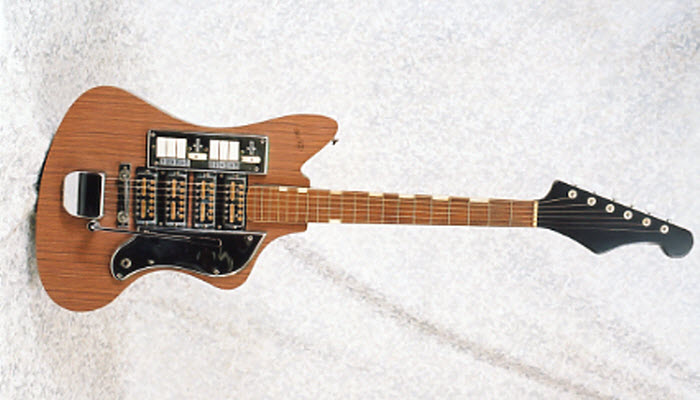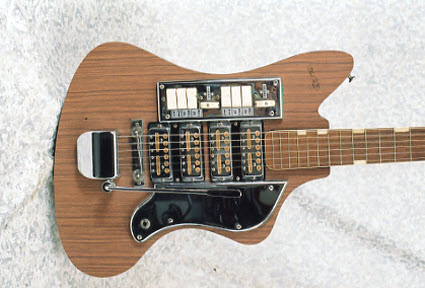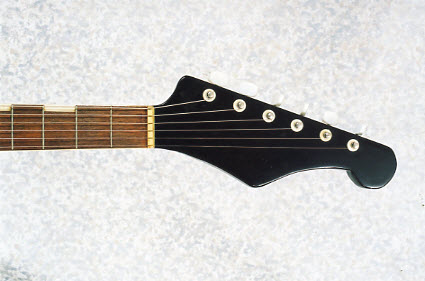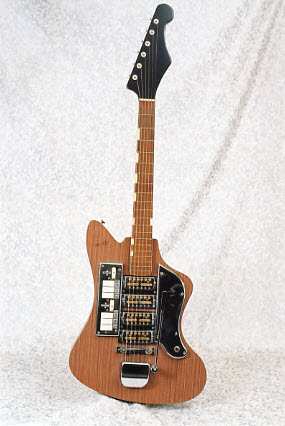
Look, I obsess as much as any old guitar nut about fancy tone woods. I love flame. I love burl. I love spalting (although I guess that’s not too good for the tree). I love any exotic timbers, like purpleheart. I also like those fancy pearl-encrusted jobs, like Mike’s Tuxedo Custom. So naturally, when I saw this little Teisco guitar, there’s no way I could resist. How do you say “No” to a guitar covered in mother-of-dinette?
Teisco guitars have run a curious course in the opinion of vintage guitar fans. There was a time when any unidentified Japanese guitar from the 1960s—and that was just about all of them, even with brand names—was said to have been “made by Teisco,” and was generally held in disdain. Then, what used to be just cheap old guitars became collectible “vintage” guitars and before you knew it, Teisco and other el-cheapos were all of a sudden desirable and treated more or less seriously.
Teisco guitars were somewhat unusual back in the 1960s because many—though certainly not all—were imported into the U.S. by Westheimer Sales carrying their own company’s brand name. There actually was a Teisco company! In fact, it was the late Jack Westheimer who appended the “del Rey” suffix to give the brand a little more “Spanish” veneer. By around 1964 or so another company called W.M.I., which stood for Weiss Musical Instruments, started importing Teisco del Reys, as well. Westheimer’s interest was more engaged in other brands he was selling, so he didn’t complain about W.M.I.’s usurping his brand name.
The object of my desire seen here is a c. 1963 Teisco SD-4L, which could have been brought in by Westheimer or someone else. For a guitar that was once regarded as something close to junk, laughed at by Les Paul and Strat aficionados, this is actually a pretty remarkable piece of lutherie for its time, the formica facing notwithstanding. The body is laminated, which the more snobbish call “plywood.” The neck is one-piece maple with a bound rosewood fingerboard. I don’t know if this has a reinforced neck; if it does, it’s certainly not adjustable. It’s pretty straight, however.
The ultimate inspiration for this guitar was the Fender Jazzmaster, which was, at the time this was introduced, still Fender’s top-of-the-line. However, it’s probably more by way of European translation. Very early in the history of Japanese exports to the U.S. they determined that their chief competition was Italian and, to a lesser extent, German guitars. And they were often loosely based on the Jazzmaster. The presence of four pickups, rocker switches, and thumbwheels clearly takes its inspiration from the Europeans. However, the nifty, top-mounted chrome housings that hold the controls are more of a nod to Supro.
A faux walnut top, the groovy shape, and four pickups are enough to recommend this guitar. But the neatest part is under the hood. The thumbwheels are master volume and tone. I’ve always thought that each pickup having both was overkill and impossible to use outside of a studio. Notice this has six rocker switches. Four of the rockers are simple on-off swtiches for each pickup. The other two, marked “Rhythm/Solo,” are actually phase reversal switches. Using these required that each pair of pickups (front and back) be on. The Solo position gives you both pickups in series or flat out. The Rhythm position reverses the phasing, giving you that funky in-between sound so cherished on Strats. Pretty cool.
The vibrato is also interesting. It sits on a little elevated platform above the guitar top and operates with three springs, one of the earliest 3-spring vibratos on a Japanese guitar I know of. All in all this is a great little guitar for getting down with “Walk, Don’t Run.” Once you get everything all set up, it plays very nicely indeed.
I’ve called this a 1963. In ’62 when these were introduced, the pickups were large chunky chrome affairs with a black bobbin center. By ’63 they had changed to these quasi-DeArmond gold foil single-coils (which are not bad, by the way). The Teisco SD-4L (and a companion 2-pickup SD-2L) only lasted into 1964. There’s a perception that Japanese guitars such as Teisco were imported by the millions, but, in fact, quantities were not really that large. The biggest year was 1966, when 618,000 guitars were imported, including all electrics and acoustics. It’s probably fair to conclude that this particular model is relatively scarce. In any case, when it was made nobody thought that inexpensive Japanese guitars were worth saving or would become collectibles! I’m sure glad this one made it. I love it! Mother-of-dinette and all.




You forgot to mention that these pick ups are the ones that Ry Cooder likes.
He usually either uses this same guitar, but with a red body, or – he removes these
pick ups and installs one of them on a Fender Telecaster , in the neck position.
Same can be said for the 1964 Teisco SS-4L.
Check out this website – ID PARADE & 4 pick ups.
http://www.mark-cole.co.uk/teisco/index.htm
Cool guitar. Is the scale the same as a Jazzmaster?
I have a similar looking guitar bought in Quebec around 1966.the peg head logo says Pyramid.I can find no information on its origins or maker.Are you or anyone familiar with this make?
Off-topic, but:
I wonder if Eastwood has ever considered a tribute to the Teisco TB-64 six-string bass.
Kazu Makino of Blonde Redhead helped make them famous amongst the hipsters…
Nobody can find one anymore, some guy wanted like $ 2900 for one on Ebay, you could pretty much corner the market.
Plus you’d sell two of ’em right off the bat ’cause we need ’em for ShiceSquad.
What do you think?
Yeah, make a “Bass-6”, make one lefty one, and presto! another guaranteed sale!!
I MANAGED TO GET A SD 4L IN A DEAL WITH AN AIRLINE RESOGLASS, I WOULD NOT PART WITH EITHER OF THEM, THE SOUND OF EACH IS SUPERB FROM 50’S TWANG TO A SWEET JAZZY TONE THAT YOU WOULD KILL FOR
RAY MAJORS
LONDON ENGLAND
In the 60’s, I owned a Teisco SD-4L exactly like the one you have in the picture above. One day in the
late 80’s I walked into a music store in Waukegan, IL and heard a young man playing a guitar in the
back room. As we got to talking, he told me he played in a band and I mentioned that I had an unusual guitar in excellent condition with a lot of push buttons, dials and chrome on it and I was thinking of selling it. He asked me if I would bring it into the store one day as he was quite interested in seeing it. The moment he did he bought it. The Teisco SD-4L was a real eye catcher. It was a bit on the heavy side compared to other flat guitars, but I loved mine and I received many compliments through the years.
I believe Pyramid did some stuff for Rush in the early days. They were an extremely small company so there may not be much info out there.
look what i had in the 60`s…the same guitar but named KENT.
Actually have that identical guitar with the Weiss name on it, parents got me it in 1962, played it for years was a good guitar.
My mate had a red one of these but it was called an ‘Orbit Four’ identical except for the colour..
I have a Teisco SS4L Kent 1964 For Sale,in Coffin Hard Case,Need money,will accept reasonable offer,live in LA Cal.email,wolfmanhowl1@gmail.com.I also have over 80 vintage guitars For Sale.All different Price ranges.Thanks Michael Davis I was raised in Waukegan Ill.
I had a red one bought new in Shaftesbury Avenue London in 1967.
It cost 19 Guineas. It was superb!